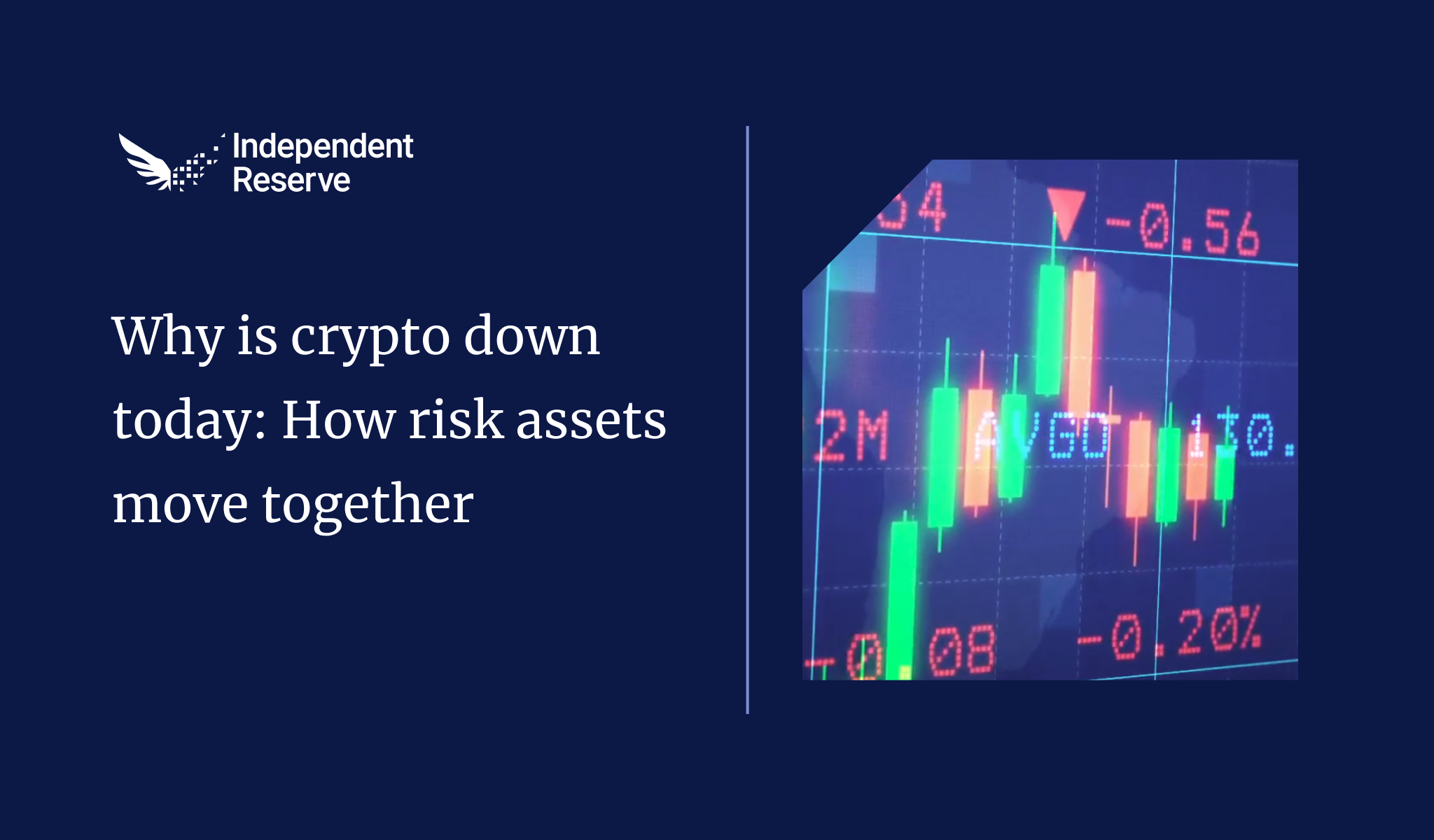In Markets
Even after the US Government spooked markets by moving US$2 billion (A$3B) in Bitcoin confiscated from Silk Road, BTC finished the week up 2% to trade at A$107,796 (US$70,939). Ethereum had a sudden surge overnight to A$5,584 (US$3,680), finishing up 6% on seven days ago. Did ETH just bottom out after falling below the 0.05 BTC mark for the first time since 2021? Who knows, but options data suggests there’s potentially another A$454 (US$300) of upside by the end of the month. Solana pulled back 1%, while XRP and Shiba Inu were flat, and Dogecoin reversed by 1.5%. The Crypto Fear and Greed Index is at 76, or Extreme Greed.

From the IR OTC Desk
Rising bond yields and persistent inflation should be influencing the price of risk assets. The practical outcome, however, is that many risk assets continue to trade somewhat independently of the macroeconomic story. Cryptocurrencies are included in these independent assets, as well as US technology companies with sound balance sheets and large cash stockpiles. These risk assets have naturally performed asymmetrically to those with large debt burdens and are under the persistent challenges of a tightening credit cycle and higher refinancing costs. In general, the unique supply side dynamics of cryptocurrencies help maintain their pricing independence and uncorrelated risk profile, and this will likely continue post the halving.
With much of the risk asset market increasingly cautious of escalating middle eastern geopolitical risk, market direction has been less clear, and range bound. Crude oil has remained on an upward pricing trajectory, although the path has been choppy, now trading just below US $90/barrel. US 10-year treasury note yields have peaked intraday at 4.44% – the highest yield for the calendar year. Critical to both pricing inputs will be US CPI (March), which is scheduled for release on tomorrow at 11:30pm AEST.
In his most recent communication, Federal Open Market Committee Chair Jerome Powell suggested that 75bps of interest rate cuts for the calendar year 2024 remains the Committee’s base case. This week’s US inflation print may be quite defining in whether this trajectory seems valid. It is also likely that confirmation of either softening or persistent US inflation will be critical to the AUD/USD currency pair – which has been well contained in at US 0.6450/0.6650 range for the last few months. At some point, the most recent ranges will break. For now, we wait for a catalyst.
On the OTC desk, the halving is now within sight. Activity in BTC trading has picked up as a result, with a combination of BTC dip buying, as well as opportunistic pre-halving selling. This has balanced the flow across the desk.
While outages in the Solana network have caused many transactions to void, we have not seen any direct concern from the OTC customer base. The ‘outage’ has naturally slowed much of the SOL network alt coin enquiry.
Perhaps the biggest beneficiary of the outage has been ETH (call this switching or substitution). ETH/BTC has most recently remained in a long term downtrend beginning September 2022 – and most recently ETH/BTC dipped below 0.05 for the first time since Q1, 2021. It seems highly likely that the Solana outage is the cause for ETH/BTC to be trading back above 0.05.
For any further information, please feel free to reach out.
In Headlines
The halving approacheth
The Bitcoin halving is just a week and a half away. That’s when the Bitcoin mining block reward is cut in half, reducing the increase in the BTC supply. Steno Research said this week it’s likely to be a “buy the rumour sell the news event” like it was in 2016 when Bitcoin was down by 8.4% three months later. However almost everyone expects the price to surge in the long run. If the price performs as it did in 2020, Bitcoin would hit US$435K (A$658K) by the time of the next halving in 2028, however the price increase also roughly halves each time, which would put the price at US$303K (A$459K) by 2028.
Runes to push up fees around halving
Ordinals founder Casey Rodarmor will launch his new fungible token protocol called Runes at the halving. It’s a successor/competitor to the unauthorised BRC-20 token standard on Bitcoin. While Runes will require fewer on-chain minting transactions, a rush of memecoin speculators could see a surge of speculative interest and much higher fees.
Solana doesn’t work
The memecoin frenzy on Solana was the catalyst for 75% of all transactions failing on April 4. The TLDR is that high usage meant transactions often failed, prompting arbitrage bots to spam lots of transactions in the hope some high return transactions would go through. This led to the majority of transactions failing. “Bots spam better than humans, so users get the worst end of the stick and get dropped the most,” explained Mert Mumtaz CEO Of Solana dev platform Helius Labs. The devs have targeted April 15 for a fix and are talking about a dynamic base fee to prevent spam.
Hard money or hardly money?
Ethereum core devs have proposed a change to issuance that disincentivises staking beyond a certain point. Currently around 27% is staked and there are concerns this could grow to 100%. The proposal has been met with horror by the “ETH is sound money” crowd, who are concerned that mucking about with monetary policy makes ETH look bad next to Bitcoin. The proposal has also highlighted Ethereum’s centralised governance – research shows that just 10 people are responsible for 68% of the Ethereum Improvement Proposals implemented. This may assist the SEC if it ever tries to make the legal case ETH is a security.
Bitcoin ETF news
The Bitcoin ETFs saw four out of five positive inflow days last week, taking in between US$40.3M (A$61M) and US$213M (A$322M) each day except on April Fool’s Day when there was a US$85.7M (A$130M) outflow. Grayscale holders continue to dump hard each day though. Meanwhile, BlackRock has added five new major Wall Street firms as authorised participants: ABN AMRO Clearing, Citadel, Citigroup Global Markets, Goldman Sachs, and UBS Securities. Over in Hong Kong, two of China’s biggest asset managers, Harvest Fund and Southern Fund, have submitted applications via their local arms, to run Bitcoin ETFs in the city state. And Marcus Thielan from 10x Research put out research yesterday highlighting that the US$10 billion (A$15.3B) growth in USDC and USDT in the past month was double that of the Bitcoin ETFs, meaning they are probably a better signal of demand. “Stablecoin issuers are the new sheriff in town, driving this market higher,” he wrote.
Do Kwon is guilty
A New York jury has found founder Do Kwon and Terraform Labs liable for six civil fraud charges brought by the SEC in connection with the implosion of the Terra ecosystem in May 2022. Kwon also faces criminal charges over the collapse in the US and Korea. There is currently a spirited debate over whether the Ethena USDe stablecoin project is as risky as Terra’s UST was. It offers 37.1% annual return, hit a market cap of US$2 billion (A$3B) extremely quickly and most people don’t understand its model of balancing longs with shorts via centralised exchanges to maintain the peg. While some respected analysts like Nic Carter and Bitmex Research think the comparisons are unwarranted, the founders of Aave were so worried about Maker tipping money into USDe, they proposed dropping Maker DAI as collateral on the lending protocol.
Coinbase wins kind-of
The U.S. Court of Appeals for the Second Circuit confirmed that secondary sales of cryptocurrencies on exchanges are not securities. It made the determination as part of a civil action by Coinbase traders who sued the exchange over losses. However, the judge said the case shouldn’t have been dismissed originally due to a change in the user agreement and sent the suit back to the district court.
Bits and pieces
Santiment reports that Bitcoin sentiment has been negative for three weeks in a row now… but that’s a good thing as it implies the likelihood of future price rises. JPMorgan analyst Nikolaos Panigirtzoglou says that if the SEC denies the Ether ETF in May, litigation will follow and “the most likely scenario is that the SEC eventually loses this litigation.” Failed crypto lender Genesis contributed to a week of Bitcoin ETF outflows by selling all its GBTC holdings. It’s now just bought 32,041 Bitcoin with some of the proceeds to reimburse its clients. Ethereum L2 Base is growing very fast: it’s now the third largest L2 with TVL of US$4.17B (A$6.3B) and the network has hit a record 35 transactions per second. It’s also about to overtake Arbitrum on monthly active users.


